Intel SSD 730 (480GB) Review: Bringing Enterprise to the Consumers
by Kristian Vättö on February 27, 2014 12:00 PM EST- Posted in
- Storage
- SSDs
- Intel
- Intel SSD 730
Random Read/Write Speed
The four corners of SSD performance are as follows: random read, random write, sequential read and sequential write speed. Random accesses are generally small in size, while sequential accesses tend to be larger and thus we have the four Iometer tests we use in all of our reviews.
Our first test writes 4KB in a completely random pattern over an 8GB space of the drive to simulate the sort of random access that you'd see on an OS drive (even this is more stressful than a normal desktop user would see). I perform three concurrent IOs and run the test for 3 minutes. The results reported are in average MB/s over the entire time. We use both standard pseudo randomly generated data for each write as well as fully random data to show you both the maximum and minimum performance offered by SandForce based drives in these tests. The average performance of SF drives will likely be somewhere in between the two values for each drive you see in the graphs. For an understanding of why this matters, read our original SandForce article.

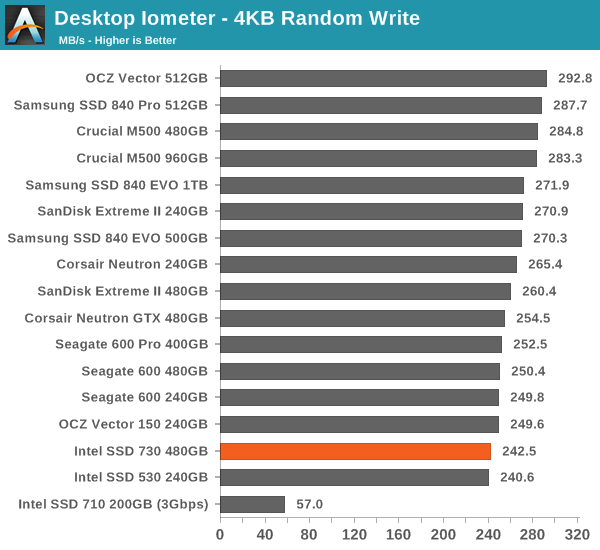
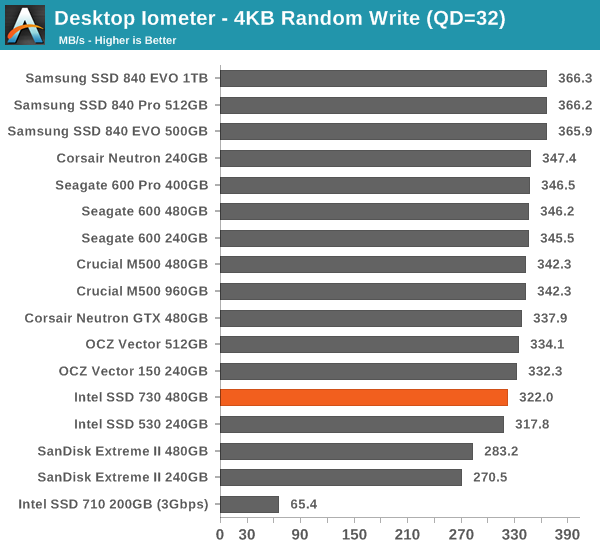
The SSD 730 isn't the fastest in peak performance because that's irrelevant in the enterprise space. We are still looking at decent random write performance and the random read performance is actually surprisingly good.
Sequential Read/Write Speed
To measure sequential performance I ran a 1 minute long 128KB sequential test over the entire span of the drive at a queue depth of 1. The results reported are in average MB/s over the entire test length.
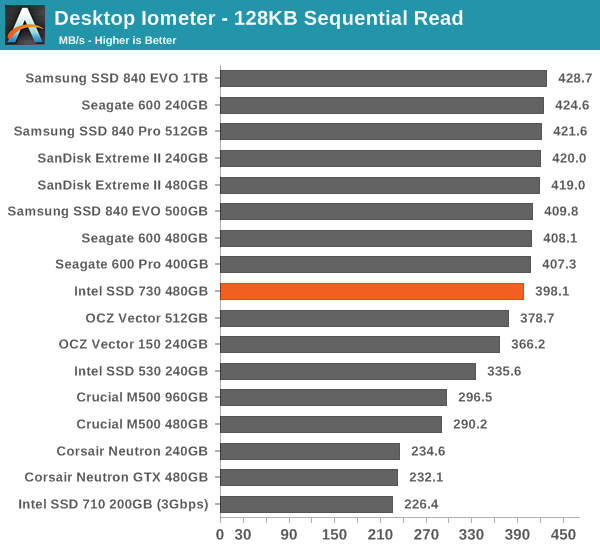
The same goes for sequential performance: the 730 is an average performer with focus on consistency.
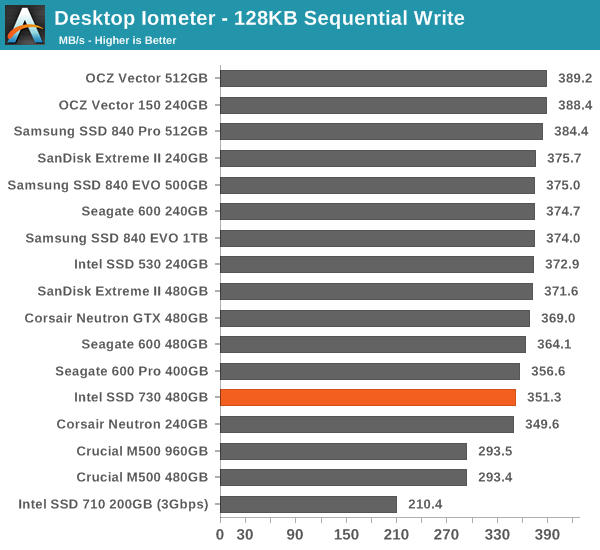
AS-SSD Incompressible Sequential Read/Write Performance
The AS-SSD sequential benchmark uses incompressible data for all of its transfers. The result is a pretty big reduction in sequential write speed on SandForce based controllers.
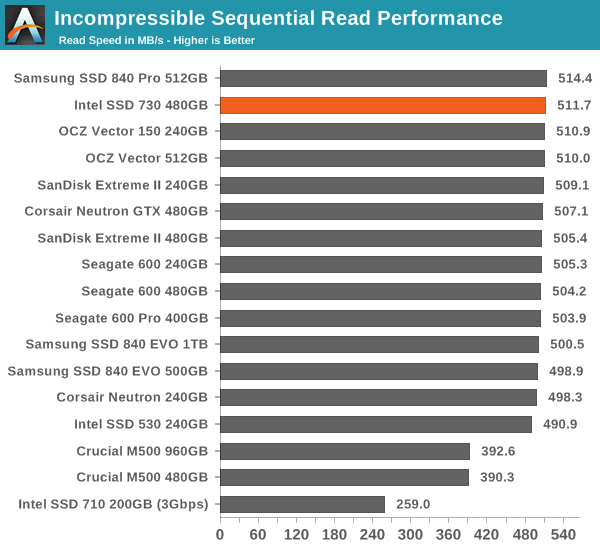
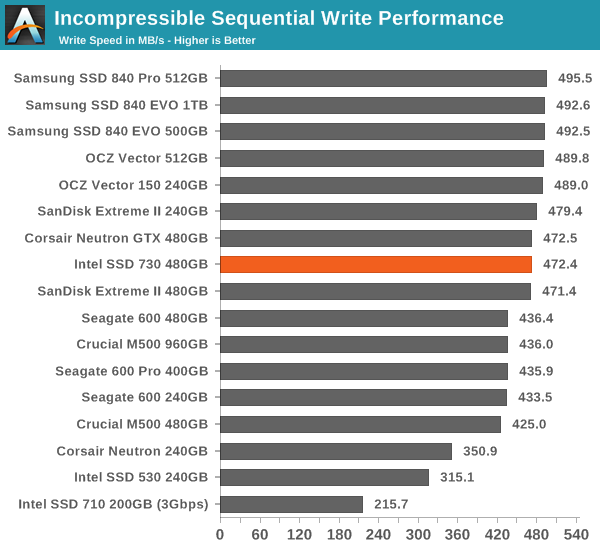










96 Comments
View All Comments
Namey - Friday, February 28, 2014 - link
AgreededDeath666Angel - Friday, February 28, 2014 - link
Hm, so the Oxford Dictionary recognized word "monies" sounds uneducated to you? And it seems that documentated and adaptated are perfectly fine and acceptable words as well. Just because you don't use them in every day language or they sound weird does not mean they are not correct. There are many different types of spoken and written English language. And making fun of one of the (correct) ways to write that language does seem, what's the word, uneducated. :PMipmap - Thursday, February 27, 2014 - link
"build a drive significantly that was better than the other offerings."build a drive that was significantly better than the other offerings.
JarredWalton - Thursday, February 27, 2014 - link
Man, I seriously flubbed that sentence/paragraph on the editing pass. I think I tried to copy/paste to rearrange words but somehow missed. LOLGuspaz - Thursday, February 27, 2014 - link
The endurance figures must be wrong. They're quoting that the drive supports only 267 cycles before it dies (128TB / 480GB = ~267), which is absurdly low. This is supposed to be high endurance MLC, but even Samsung's TLC has multiple times higher endurance than that...KAlmquist - Thursday, February 27, 2014 - link
Perhaps Intel is assuming 3000 cycles and a worst case write amplification of 12. (If you aren't familiar with write amplification, see Anand's early SSD articles on this site.)Guspaz - Thursday, February 27, 2014 - link
Intel previously claimed a write amplification of 1.1 way back in the G1 days. Are you saying that this drive has an order of magnitude worse write amplification than their oldest drives?futrtrubl - Friday, February 28, 2014 - link
Remember that they are using enterprise metrics and not client metrics on this. It could be the you can be more flexible on the WA you can assume on client drives.Guspaz - Friday, February 28, 2014 - link
Perhaps, but don't you think that the order of magnitude reduction in claimed write endurance deserves a call out in the article, if only to explain why that's the case?KAlmquist - Friday, February 28, 2014 - link
The 1.1 write amplification was presumably typical rather than worst case. I wouldn't expect the write amplification to be that much different from the G1. The large block and page sizes probably make write amplification a bit worse, but the algorithms may have improved a bit.I agree with your comment below that it would have been nice if the reviewer had queried Intel about the endurance spec, rather than leaving us to speculate.